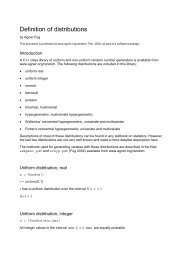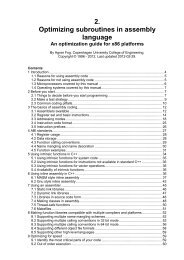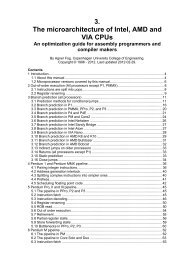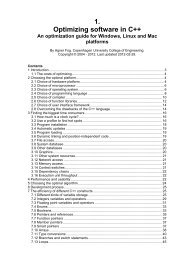4 Instruction tables - Agner Fog
4 Instruction tables - Agner Fog
4 Instruction tables - Agner Fog
You also want an ePaper? Increase the reach of your titles
YUMPU automatically turns print PDFs into web optimized ePapers that Google loves.
μops<br />
Execution<br />
unit<br />
Execution<br />
port<br />
<strong>Instruction</strong><br />
set<br />
Definition of terms<br />
Uop or μop is an abbreviation for micro-operation. Processors with out-of-order cores<br />
are capable of splitting complex instructions into μops. For example, a read-modify instruction<br />
may be split into a read-μop and a modify-μop. The number of μops that an<br />
instruction generates is important when certain bottlenecks in the pipeline limit the<br />
number of μops per clock cycle.<br />
The execution core of a microprocessor has several execution units. Each execution<br />
unit can handle a particular category of μops, for example floating point additions. The<br />
information about which execution unit a particular μop goes to can be useful for two<br />
purposes. Firstly, two μops cannot execute simultaneously if they need the same execution<br />
unit. And secondly, some processors have a latency of an extra clock cycle<br />
when the result of a μop executing in one execution unit is needed as input for a μop<br />
in another execution unit.<br />
The execution units are clustered around a few execution ports on most Intel processors.<br />
Each μop passes through an execution port to get to the right execution unit.<br />
An execution port can be a bottleneck because it can handle only one μop at a time.<br />
Two μops cannot execute simultaneously if they need the same execution port, even<br />
if they are going to different execution units.<br />
This indicates which instruction set an instruction belongs to. The instruction is only<br />
available in processors that support this instruction set. The different instruction sets<br />
are listed at the end of this manual. Availability in processors prior to 80386 does not<br />
apply for 32-bit and 64-bit operands. Availability in the MMX instruction set does not<br />
apply to 128-bit packed integer instructions, which require SSE2. Availability in the<br />
SSE instruction set does not apply to double precision floating point instructions,<br />
which require SSE2.<br />
32-bit instructions are available in 80386 and later. 64-bit instructions in general purpose<br />
registers are available only under 64-bit operating systems. <strong>Instruction</strong>s that use<br />
XMM registers (SSE and later) are only available under operating systems that support<br />
this register set. <strong>Instruction</strong>s that use YMM registers (AVX and later) are only<br />
available under operating systems that support this register set.<br />
How the values were measured<br />
The values in the <strong>tables</strong> are measured with the use of my own test programs, which are available<br />
from www.agner.org/optimize/testp.zip<br />
The time unit for all measurements is CPU clock cycles. It is attempted to obtain the highest clock<br />
frequency if the clock frequency is varying with the workload. Many Intel processors have a performance<br />
counter named "core clock cycles". This counter gives measurements that are independent of<br />
the varying clock frequency. Where no "core clock cycles" counter is available, the "time stamp<br />
counter" is used (RDTSC instruction). In cases where this gives inconsistent results (e.g. in AMD<br />
Bobcat) it is necessary to make the processor boost the clock frequency by executing a large number<br />
of instructions (> 1 million) or turn off the power-saving feature in the BIOS setup.<br />
<strong>Instruction</strong> throughputs are measured with a long sequence of instructions of the same kind, where<br />
subsequent instructions use different registers in order to avoid dependence of each instruction on<br />
the previous one. The input registers are cleared in the cases where it is impossible to use different<br />
registers. The test code is carefully constructed in each case to make sure that no other bottleneck<br />
is limiting the throughput than the one that is being measured.<br />
<strong>Instruction</strong> latencies are measured in a long dependency chain of identical instructions where the<br />
output of each instruction is needed as input for the next instruction.<br />
The sequence of instructions should be long, but not so long that it doesn't fit into the level-1 code<br />
cache. A typical length is 100 instructions of the same type. This sequence is repeated in a loop if a<br />
larger number of instructions is desired.<br />
Page 4






